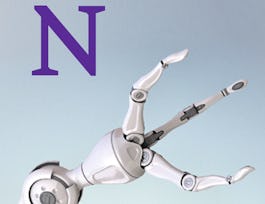This course, which is the last and final course in the Introduction to Robotics with Webots specialization, will teach you basic approaches for planning robot trajectories and sequence their task execution. In "Robotic Path Planning and Task Execution", you will develop standard algorithms such as Breadth-First Search, Dijkstra's, A* and Rapidly Exploring Random Trees through guided exercises. You will implement Behavior Trees for task sequencing and experiment with a mobile manipulation robot "Tiago Steel".



Robotic Path Planning and Task Execution
This course is part of Introduction to Robotics with Webots Specialization

Instructor: Nikolaus Correll
Sponsored by Mojatu Foundation
Recommended experience
What you'll learn
Use discrete planning techniques such as Dijkstra and A* to compute optimal robot trajectories.
Implement complex sequences of behaviors using behavior trees.
Plan and implement a complex robotic controller for autonomous mobile manipulation behavior.
Details to know

Add to your LinkedIn profile
9 assignments
See how employees at top companies are mastering in-demand skills

Build your subject-matter expertise
- Learn new concepts from industry experts
- Gain a foundational understanding of a subject or tool
- Develop job-relevant skills with hands-on projects
- Earn a shareable career certificate


Earn a career certificate
Add this credential to your LinkedIn profile, resume, or CV
Share it on social media and in your performance review

There are 5 modules in this course
The first week in this course provides an introduction to path planning and presents a series of optimal algorithms for finding the shortest path on a graph that increase in complexity and efficiency. You will be introduced to various algorithms, including Bread-First Search to Dijkstra's and A*.
What's included
8 videos10 readings2 assignments1 discussion prompt
In this week, you will learn how to efficiently plan in non-grid worlds and in high-dimensional spaces.
What's included
1 video4 readings3 assignments
This week introduces you to a new programming abstraction known as "Behavior Trees", which offers solutions to shortcomings of Finite State Machines and simple reactive controllers.
What's included
1 video4 readings2 assignments1 peer review
This week you will learn how to extend a mobile base with a robotic arm and trigger the ability to grasp objects.
What's included
2 readings2 assignments
In this last week, you will complete a final project to demonstrate your knowledge of both this course and the entire specialization. It consists of implementing a complete mobile manipulation solution.
What's included
1 video1 peer review
Instructor

Offered by
Why people choose Coursera for their career




Recommended if you're interested in Computer Science

Coursera Project Network

Universidades Anáhuac

University of Colorado Boulder

Northwestern University

Open new doors with Coursera Plus
Unlimited access to 10,000+ world-class courses, hands-on projects, and job-ready certificate programs - all included in your subscription
Advance your career with an online degree
Earn a degree from world-class universities - 100% online
Join over 3,400 global companies that choose Coursera for Business
Upskill your employees to excel in the digital economy


